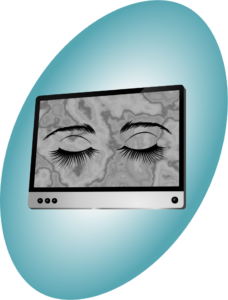Idle visions
When I close my eyes in the presence of light (particularly when it’s bright), I can still see an ‘image imprint’ for a few seconds, even though my eyelids cover my eyeballs. My pupils tend to dilate as the imprinted image fades away. A strong light source can penetrate my eyelids, and I can still sense if there are changes in the light intensity around me. In addition, light passing through my closed eyelids can give visual indications of the blood circulating in them.
An interesting case is when there is no sensory input to the eyeballs, for example, when I’m in total darkness or when I cover my eye cavities tightly with the cushions of my palms. In the absence of light, there is still plenty of visual action. Something similar to a computer screensaver replaces my visions. I don’t see a uniformly black image but rather faint images that change dynamically. The images resemble a changing aquarelle painted in different gray shades. I may see ‘glow-in-the-dark’ specks of light moving around, various geometric shapes, flashes, traces of colors, and other ‘special effects.’ That is my idle vision.
Even while totally preventing light from my eyeballs, my eyes continue to send visual signals. That is because my brain needs light contrast to perceive black. It’s like I have an inner source of faint illumination, keeping my eye sensors active and functional. Or put in other words, my ‘inner camera’ continues to record blank videos.
When light falls on my eyelids, there is an overlay on my internal idle vision, and I can get indications from the blood circulating in my eyelids. However, in absolute darkness, it’s purely indications from my ‘inner light generation.’
The visions in my dreams display on the ‘same screen,’ which shows my ‘idle vision’ when there is no light. For now, we don’t understand the deep meaning of our dreams; they are still a mystery. Likewise, we have no profound understanding of the meaning of these faint visions when we close our eyes. Nevertheless, I can get some indications from these images, as I can from my dreams.
Things that impact my idle vision:
- Last image I look at before cutting off light sources.
- Changes in light passing through my closed eyelids.
- Eyelid and eyeball
- Coughing, sneezing, or other abrupt exhalations.
- Breathing.
- Emotions and thoughts.
Possible indications from the images:
- Pulsating or throbbing areas on the ‘screen.’
- Change in images when switching from inhaling to exhaling.
- Visions intensity.
- The speed at which images change.
- Symmetry and shapes.
- Spots of non-grayscale colors on the image.
- Irregular images.
The idle visions on my ‘screensaver’ relate to my emotional and physical state. They may also indicate how different breathing practices affect me.
For example, a pulsating area on my idle visions (particularly at the bottom of the ‘screen’) may indicate I’m not relaxed. It may also appear when I breathe intensively. After getting acquainted with my idle vision, I managed to spot more subtle indications. For example, I often see spirals when I hyperventilate intensively.

